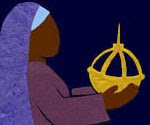I feel moved to focus my reflection this week on chapters 8-10, and to leave aside chapter 11 this time around, though 11 is arguably the climax of the entire Book of Mormon. Instead I want to focus on the story leading up to that: the cataclysmic destruction that comes as the sign of Christ's death, and the three days of darkness that follow.
If you've read my reflection on Helaman 13-16, then you can probably guess how I felt about 3 Nephi 8-10, with its representation of God as destroyer. But let me skirt that stumbling block and approach the reading in a more teachable frame of mind. What does the Spirit have to teach me here?
Probably a FARMS paper, maybe even an Ensign article, has already been written on this subject; but during my reading of these chapters this time around, I realized for the first time that the story in 3 Nephi 8-10 reproduces on a social scale a pattern for conversion we've already seen enacted in other stories in the Book of Mormon on a personal scale. Think back to the conversion of Alma the Younger and the conversion of Lamoni. In both those stories, a sinner is smitten so that he falls into a death-like trance, which for Alma is also a hell-like state. (Arguably we're supposed to imagine something similar for Lamoni.) They're in this state for two days and two nights, and then on the third day they rise again, declaring that they have been saved. This trance-and-rebirth is clearly a type of the death and resurrection of Jesus.
3 Nephi 8-10 involves a similar typology. Sinners are smitten—which in this case means cities are destroyed and multitudes are killed. All this is supposed to be happening as a sign of Jesus' death—more or less coinciding with his death—so here the type actually meets the reality to which it points. (I say "more or less" because if you think about the chronology carefully, the three days of darkness can't exactly coincide with the time between Jesus' death and resurrection as narrated in the Gospels unless the "three days" are really one full day plus the afternoon of the day before, ending on the morning of the day after.) The survivors are plunged into a hell-like state in which they howl and bewail the sins that have led them to this doom. Then Christ speaks to them, offering them hope if they repent. And though we're not actually told that the people accept that offer, on the morning after the three days of darkness, the light returns, mourning turns into joy, and the people give "praise and thanksgiving to the Lord Jesus Christ, their Redeemer."
It's a charismatic nineteenth-century revival-type crisis conversion, like those of Alma the Younger and Lamoni, magnified to a society-wide scale.
What does the Spirit want me to take from this?
The story in 3 Nephi 8-10, like the conversion stories of Alma and Lamoni, links conversion typologically to the death and resurrection of Jesus. Shifting toward a Pauline mode of language: we enter the Christian life by participating in Christ's death and resurrection. We die with Christ, and then God raises us to new life with Christ. That's what baptism by immersion symbolizes. Pushing the imagery farther, into an even more mystical direction, it's one of the things the sacrament symbolizes. When I eat the broken bread that is, to my soul, Christ's broken body, and when I drink the wine/water that is, to my soul, Christ's blood shed for me, I am assimilating into myself Christ's suffering and death—I am making myself one with his suffering and death—and by so doing, I am participating in (partaking in!) the new life that comes from always having Christ's Spirit with me, living in me, so that I become part of Christ's living body on earth, carrying out his ministry until the end of the world.
Okay. Yeah. What else?
Let's look back at the text. Coming to Christ, coming into Christ, becoming one with Christ, partaking of Christ's death and resurrection means repenting—adopting a new way of life, committing to standards that demand change in my daily living. It means being healed (9:13)—that is, I suppose, recognizing that I am spiritually unwell, unhealthy, that I'm not functioning at my soul's full capacities, my capacities for Christlikeness; that I'm wounded, that I've been hurt. And Christ wants to work in me to remedy all that. Coming to Christ means becoming one of the "sons of God" (9:17)—that is, I stand in the same intimate relationship with God that Christ does as Son of God, with God in me and me in God (9:15). Coming to Christ means having a broken heart and a contrite spirit (9:20)—which has various meanings, but the one that stands out to me at the moment is that of being vulnerable and sharing others' sorrows.
This is all rather abstract: I'm not applying it yet to my life in a concrete way. But unfortunately, I have to move on to other tasks. I pray that these reflections will continue to work in my mind and heart.
Sunday, September 14, 2008
Subscribe to:
Post Comments (Atom)


No comments:
Post a Comment